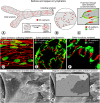Dynamics of airway blood vessels and lymphatics: lessons from development and inflammation
- PMID: 22052927
- PMCID: PMC3359074
- DOI: 10.1513/pats.201102-022MW
Dynamics of airway blood vessels and lymphatics: lessons from development and inflammation
Abstract
Blood vessels and lymphatic vessels in the respiratory tract play key roles in inflammation. By undergoing adaptive remodeling and growth, blood vessels undergo changes that enable the extravasation of plasma and leukocytes into inflamed tissues, and lymphatic vessels adjust to the increased fluid clearance and cell traffic involved in immune responses. Blood vessels and lymphatics in adult airways are strikingly different from those of late-stage embryos. Before birth, blood vessels in mouse airways make up a primitive plexus similar to that of the yolk sac. This plexus undergoes rapid and extensive remodeling at birth. In the early neonatal period, parts of the plexus regress. Capillaries then rapidly regrow, and with arterioles and venules form the characteristic adult vascular pattern. Lymphatic vessels of the airways also undergo rapid changes around birth, when lymphatic endothelial cells develop button-like intercellular junctions specialized for efficient fluid uptake. Among the mechanisms that underlie the onset of rapid vascular remodeling at birth, changes in tissue oxygen tension and mechanical forces associated with breathing are likely to be involved, along with growth factors that promote the growth and maturation of blood vessels and lymphatics. Whatever the mechanisms, the dynamic nature of airway blood vessels and lymphatics during perinatal development foretells the extraordinary vascular plasticity found in many diseases.
Figures


References
-
- Wilson JW, Hii S. The importance of the airway microvasculature in asthma. Curr Opin Allergy Clin Immunol 2006;6:51–55 - PubMed
-
- Ebina M. Remodeling of airway walls in fatal asthmatics decreases lymphatic distribution: beyond thickening of airway smooth muscle layers. Allergol Int 2008;57:1–10 - PubMed
-
- Detoraki A, Granata F, Staibano S, Rossi FW, Marone G, Genovese A. Angiogenesis and lymphangiogenesis in bronchial asthma. Allergy 2010;65:946–958 - PubMed
-
- Ribatti D, Puxeddu I, Crivellato E, Nico B, Vacca A, Levi-Schaffer F. Angiogenesis in asthma. Clin Exp Allergy 2009;39:1815–1821 - PubMed
Publication types
MeSH terms
Grants and funding
LinkOut - more resources
Full Text Sources
